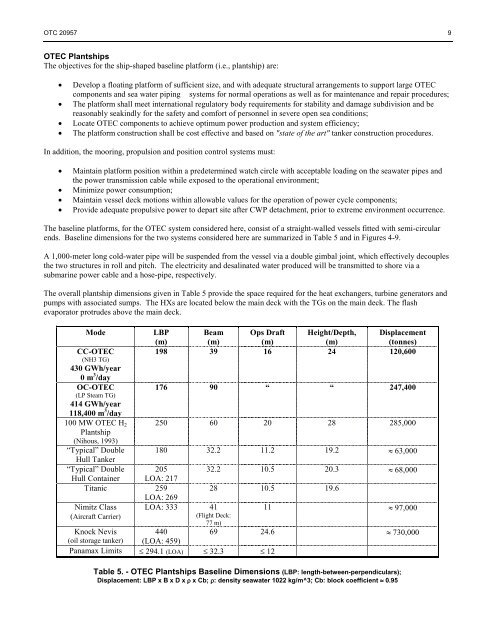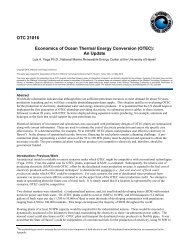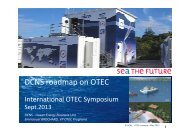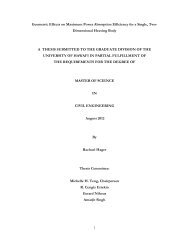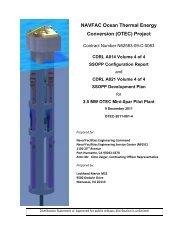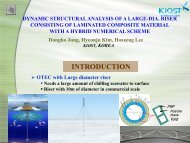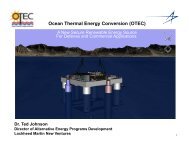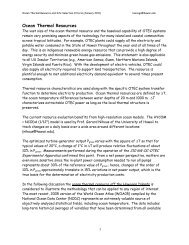50 MW OTEC Plantship Design - Hawaii National Marine ...
50 MW OTEC Plantship Design - Hawaii National Marine ...
50 MW OTEC Plantship Design - Hawaii National Marine ...
You also want an ePaper? Increase the reach of your titles
YUMPU automatically turns print PDFs into web optimized ePapers that Google loves.
OTC 20957 9<br />
<strong>OTEC</strong> <strong>Plantship</strong>s<br />
The objectives for the ship-shaped baseline platform (i.e., plantship) are:<br />
• Develop a floating platform of sufficient size, and with adequate structural arrangements to support large <strong>OTEC</strong><br />
components and sea water piping systems for normal operations as well as for maintenance and repair procedures;<br />
• The platform shall meet international regulatory body requirements for stability and damage subdivision and be<br />
reasonably seakindly for the safety and comfort of personnel in severe open sea conditions;<br />
• Locate <strong>OTEC</strong> components to achieve optimum power production and system efficiency;<br />
• The platform construction shall be cost effective and based on "state of the art" tanker construction procedures.<br />
In addition, the mooring, propulsion and position control systems must:<br />
• Maintain platform position within a predetermined watch circle with acceptable loading on the seawater pipes and<br />
the power transmission cable while exposed to the operational environment;<br />
• Minimize power consumption;<br />
• Maintain vessel deck motions within allowable values for the operation of power cycle components;<br />
• Provide adequate propulsive power to depart site after CWP detachment, prior to extreme environment occurrence.<br />
The baseline platforms, for the <strong>OTEC</strong> system considered here, consist of a straight-walled vessels fitted with semi-circular<br />
ends. Baseline dimensions for the two systems considered here are summarized in Table 5 and in Figures 4-9.<br />
A 1,000-meter long cold-water pipe will be suspended from the vessel via a double gimbal joint, which effectively decouples<br />
the two structures in roll and pitch. The electricity and desalinated water produced will be transmitted to shore via a<br />
submarine power cable and a hose-pipe, respectively.<br />
The overall plantship dimensions given in Table 5 provide the space required for the heat exchangers, turbine generators and<br />
pumps with associated sumps. The HXs are located below the main deck with the TGs on the main deck. The flash<br />
evaporator protrudes above the main deck.<br />
Mode<br />
CC-<strong>OTEC</strong><br />
(NH3 TG)<br />
430 GWh/year<br />
0 m 3 /day<br />
OC-<strong>OTEC</strong><br />
(LP Steam TG)<br />
414 GWh/year<br />
118,400 m 3 /day<br />
100 <strong>MW</strong> <strong>OTEC</strong> H 2<br />
<strong>Plantship</strong><br />
(Nihous, 1993)<br />
“Typical” Double<br />
Hull Tanker<br />
“Typical” Double<br />
Hull Container<br />
205<br />
LOA: 217<br />
Titanic 259<br />
LOA: 269<br />
Nimitz Class<br />
(Aircraft Carrier)<br />
LBP Beam Ops Draft Height/Depth, Displacement<br />
(m)<br />
(m)<br />
(m)<br />
(m)<br />
(tonnes)<br />
198 39 16 24 120,600<br />
176 90 “ “ 247,400<br />
2<strong>50</strong> 60 20 28 285,000<br />
180 32.2 11.2 19.2 ≈ 63,000<br />
LOA: 333 41<br />
(Flight Deck:<br />
77 m)<br />
440<br />
32.2 10.5 20.3 ≈ 68,000<br />
28 10.5 19.6<br />
Knock Nevis<br />
(oil storage tanker) (LOA: 459)<br />
Panamax Limits ≤ 294.1 (LOA) ≤ 32.3 ≤ 12<br />
11 ≈ 97,000<br />
69 24.6 ≈ 730,000<br />
Table 5. - <strong>OTEC</strong> <strong>Plantship</strong>s Baseline Dimensions (LBP: length-between-perpendiculars);<br />
Displacement: LBP x B x D x ρ x Cb; ρ: density seawater 1022 kg/m^3; Cb: block coefficient ≈ 0.95


